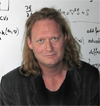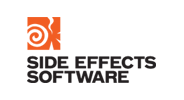
DGPis40:
Scientific Workshop & 40th Anniversary Reunion
Wednesday, May 28 - Friday, May 30, 2008
University of Toronto, Toronto, Ontario


Sponsors:
Session 2: Graphics and Animation 1
DGP is 40 and I am 42
Jos Stam [Website]
 |
Senior Research Scientist Autodesk, Inc. |
Location:
Room 1160, Bahen Centre, 40 St. George Street, University of Toronto
Abstract:
In this talk I will give an overview of my 20 years of research in computer graphics trying to highlight common themes and ideas. I will also spend some time talking about my latest project called Nucleus. Nucleus is a unified dynamics framework based on particles with constraints. The goal of this research is to unify all dynamics in a single solver so that things like cloth, rigid bodies and liquids all interact effortlessly. This research is now partially implemented in our MAYA software with the introduction of nCloth in MAYA 8.5. There will be many live real-time demonstrations in the talk to illustrate the ideas.
Bio:
Jos Stam was born in the Netherlands and educated in Geneva, Switzerland, where he received dual Bachelor
degrees in computer science and pure mathematics. In 1989, Stam moved to Toronto where he completed
his Masters and Ph.D. degrees in computer science. After that he pusrsued postdoctoral studies as a
ERCIM fellow at INRIA in France and at VTT in Finland. In 1997 Stam joined the Alias Seattle office as a
researcher and stayed there until 2003 to relocate to Alias' main office in Toronto. Stam is now employed
with Autodesk as a Senior Research Scientist as part of Autodesk's acquisition of Alias in 2006.
Stam's research spans several areas of computer graphics: natural phenomena, physics-based simulation, rendering and surface modeling, especially subdivision surfaces. He has published papers in all of these areas in journals and at conferences, most notably at the annual SIGGRAPH conference. In 2005 Stam was awarded one of the most prestigeous awards in computer graphics: the SIGGRAPH Computer Graphics Achievement Award.
Stam also won two Technical Achievement Awards from the Academy of Motion Picture Arts and Sciences: in 2005 for his work on Subdivision Surfaces and one in 2007 for his work on fluid dynamics. He was also featured in a January 2008 Wired magazine article.
21 Years at Pixar: To Infinity and Beyond
Bill Reeves
 |
Supervising Technical Director Pixar Animation Studios |
Location:
Room 1160, Bahen Centre, 40 St. George Street, University of Toronto
Abstract:
Coming soon.
Bio:
Bill studied mathematics at the University of Waterloo in Canada and received his B. Math in 1974. He then went to the University of Toronto and received a Msc. Computer Science in 1976, and a PhD. in 1980. His doctoral research in motion analysis work aided in cardiovascular research. This work also led to some new techniques for computer based inbetweening that was published in ACM SIGGRAPH in 1981.
In 1980, Bill joined the Computer Division of Lucasfilm as project leader of the systems group and a member of the computer graphics group. It was at Lucasfilm that Bill invented a new image synthesis technique called particle systems that enables the generation of very complex and detailed images. It has been used to model fire, fireworks, trees, grass, and flowers. In 1986, Bill left Lucasfilm along with most of the rest of the Computer Division and joined Pixar as head of Animation Research and Development. Bill's film credits while at Lucasfilm and Pixar include: "Star Trek II: The Wrath of Khan", "Return of the Jedi", "The Adventures of Andre and Wally B.", "Young Sherlock Holmes", "Blowin' in the Wind", "Flags and Waves", "Luxo Jr." (1986 Academy Award nominee), "Red's Dream", "Tin Toy" and "Knickknack". In 1988, Bill received an Academy Award for Best Animated Short Film for his work as Technical Director on "Tin Toy".
From 1991 to 1995, Bill worked as Supervising Technical Director on "Toy Story". "Toy Story" was honoured in 1995 by the Motion Picture Academy of Arts and Sciences with a special Oscar for groundbreaking innovation in film making. In addition, "Toy Story" was the highest grossing film released in 1995.
From 1995 until present Bill has continued to work with Pixar as a Supervising Technical Director on "A Bug's Life" and "Finding Nemo" and lead the technical preproduction team on Pixar's next two films: "The Incredibles" and "Cars". In 1997, Bill was awarded a Technical Academy Award for his invention of Particle Systems. In 1998, Bill was awarded another Technical Academy Award along with three others from Pixar for their development of the Marionette animation system, the body software Pixar has used for modelling and animation since 1988.
From 2002 to 2007, Bill worked on "Ratatouille" as Global Technology Lead. Currently, Bill is working on "Toy Story 3" which is scheduled to be released in 2010.






